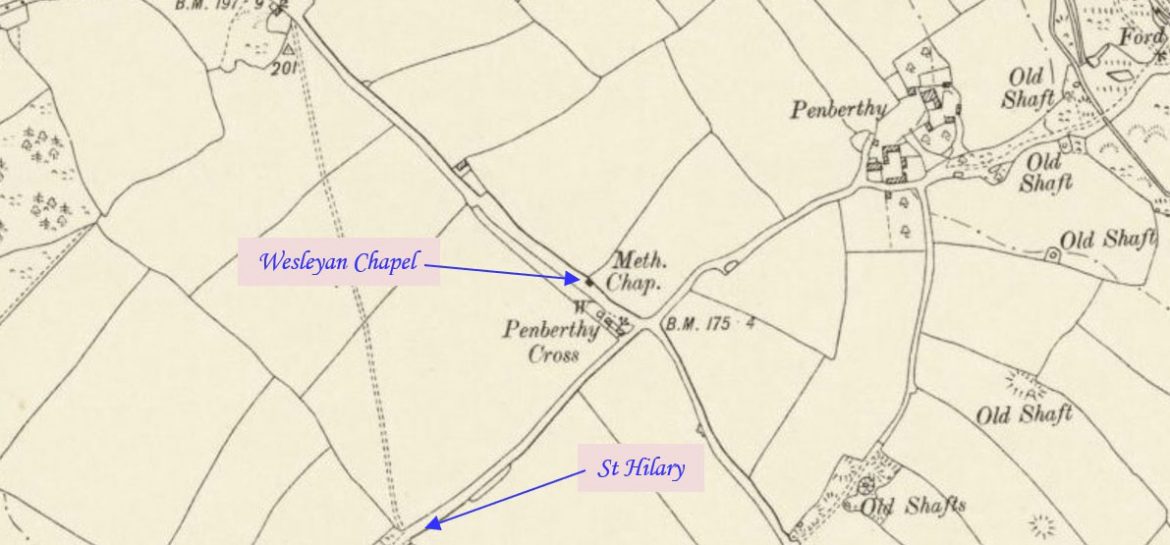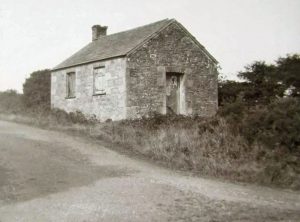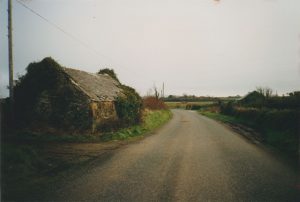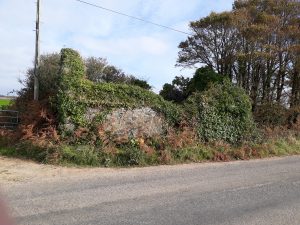
Penberthy Cross is a hamlet situated northwest of Relubbus. This profile of Penberthy Cross Wesleyan Chapel has been compiled by Mike Millichamp and Tony Mansell
Penberthy Cross Chapel is on the left when travelling along Long Lane from St Erth to St Hilary.
A Wesleyan Methodist chapel is recorded on the 1st and 2nd Edition 1880 and 1907 OS Maps. A building is still extant at the location. (Cornwall Council Heritage Gateway)
Penberthy is mentioned in with a different spelling, “There are Wesleyan chapels at Halmanning and Penburthey Cross”. (Kellys 1902)
A history of Penberthy Cross Wesleyan Chapel by Mike Millichamp
During the Cornish mining boom and the rise of Methodism then mining areas, although not heavily populated, would attract large numbers of miners, labourers, their families and associated employment such as blacksmiths.
Some of these areas were quite isolated and so wayside chapels sprung up at the roadside and sometimes at crossroads. They were isolated with very few other buildings near them.
Penberthy Cross is an example. When the mines were worked out and the miners drifted away then the chapel would be abandoned and fall into disrepair. It can be traced as current on the 1888 and 1908 Ordnance Survey maps but not recorded on the 1851 Census of Places of Public Worship.
The chapel measures 16 feet wide; 24 feet long and 5 ½ feet high from the ground to the eaves. The building looks like a traditional country domestic dwelling built in the mid-19th century. It is unlikely to have been built as a farm building because of the narrow front door and simple windows. These features would have been a luxury for a farm building of that date; with the door too narrow for livestock; and the windows not needed for farm storage purposes.
The walls, inside and out, are constructed of a single skin of local irregular shaped stone obtained from one of the many mine dumps and quarries close by. As some of the external stones show the blue copper leeching and staining the wall, then it suggests that it came from a local mine dump. The roof would have been thatch but now shows the sign that it was a slated roof, and the nearest slate quarry that I have local knowledge of is at Canon’s Town.
In addition, on the opposite side of the road lies the footprint of three cottages although there is no trace of the buildings, but where their small garden and vegetable plot used to be, is a small area of tilled land which throws up garden flowers amongst the weeds. The drinking water well is covered but there somewhere. The blacksmiths building is still there but used for other purposes.
My fellow researcher could recall the building from the early 1960s when it was no longer a chapel and used for farm storage. It probably had a wooden floor in later life which has rotted away leaving an earth floor which was self-evident by the amount of undergrowth which had taken over the inside. At the rear end there was a wooden stage which we assume the preacher stood upon to make his sermons.
However, the whole site is now totally overgrown. Nature is reclaiming what is rightfully hers and the comparison between the 1994 and 2018 photographs indicate it will not be there for much longer.
 Thought to be the Wesleyan Chapel at Penberthy Cross (Photo: courtesy Mike Mycetes)
Thought to be the Wesleyan Chapel at Penberthy Cross (Photo: courtesy Mike Mycetes)
Build date unknown.
Seating for 45. (David Easton, Methodist Minister and historian)
“… the windows are so low that shutters have to be placed over them lest they should be damaged by straying cattle.” (Cob and Moorstone by Lawrence Maker)
1878: Appears on map. (old.maps.co.uk)
1924: Re-opening services held. (Cornishman – Wednesday 12 November 1924)
1931: Penberthy Cross Wesleyan Sunday school tea treat. (Cornishman – Thursday 23 July 1931)
1932: The Wesleyan, Primitive Methodist and the United Methodist Church amalgamated to become the Methodist Church of Great Britain.
1938: Closed. (David Easton, Methodist Minister and historian)
1960s: In use as a farm store. (David Easton, Methodist Minister and historian)
Derelict. (David Easton, Methodist Minister and historian)
 1994 (Photo: Mike Mycetes)
1994 (Photo: Mike Mycetes)
 2018 (Photo: Mike Mycetes)
2018 (Photo: Mike Mycetes)
